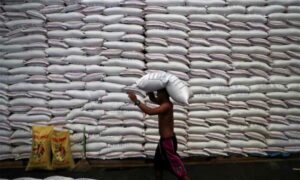Direct seeding of rice needs a fillip to improve yield

The water crisis in India prompts efforts to promote water-efficient crop production, particularly in rice cultivation. Transitioning from transplanted rice to direct seeding aims to save water, reduce labor, and mitigate climate impact. However, challenges persist, including lower yields and unsuitable soil conditions. Developing aerobic-resilient rice varieties and addressing soil salinity issues are critical. Integrated management technologies are needed to maximize productivity and bridge the yield gap between direct seeding and traditional methods.
THE prevailing water crisis is posing the biggest threat to agro-economic sustainability and socio-economic stability in India. This problem is being aggravated by global warming and climate change. Saving water and using it judiciously are now recognised as one of the top priorities in the country.
The governments and extension agencies in Punjab, Haryana and other states are motivating farmers to adopt water-efficient crop production approaches, particularly for the cultivation of rice, which is a high-irrigation crop (requiring 3,000-5,000 cubic metres of water per tonne of grain produced). One recommendation is to shift from conventional water-intensive transplanted rice (TPR) cultivation in flooded/saturated soil towards direct seeding of rice (DSR) — sowing/drilling seed in the soil at a workable moisture content, pre-emergence spraying of herbicide, first irrigation 21 days after sowing and thereafter at 5-7 days’ interval. The DSR system can save water, eliminate the labour-intensive step of transplanting, reduce costs, increase income and ensure better soil conditions for the following crops. The DSR is eco-friendly as it reduces methane (a potent greenhouse gas) emissions associated with anaerobic conditions in submerged soils (as in the TPR system), and hence can play a pivotal role in mitigating climate change.
All-out efforts are being made by the governments to increase area under the DSR in Punjab and Haryana, with proposed targets to bring 7 and 2-2.5 lakh acres, respectively, under it during 2024. Experiences of farmers in recent years and research reports of PAU, the International Rice Research Institute and others show that compared to the TPR, the DSR approach can reduce water usage by over 70 per cent for land preparation and over 20 per cent during the growth of the rice crop. However, water-saving under the DSR system comes at the cost of up to 30 per cent lower yield than the TPR system. The extent of yield loss varies with soil properties, seeding practices, water management, weed infestation, efficiency in adoption of recommended crop production management practices and agro-ecological conditions. The adoption of the DSR system by the farmers is, therefore, not growing as desired despite incentives of Rs 1,500 per acre in Punjab and Rs 4,000/acre in Haryana, being offered to them by the governments. During 2023, against the targets of bringing under the DSR about 5 lakh acres in Punjab and 2 lakh acres in Haryana, these states could manage to achieve only about 1.7 (even less than about 2.12 lakh acres achieved during 2022) and 1.78 lakh acres, respectively.
While shifting to the DSR system, the most crucial issue is that the currently cultivated high-yielding rice varieties/hybrids characteristically produce potential (maximum achievable) yields when grown under reduced (i.e. low oxidation reduction potential) anaerobic soil conditions created by keeping the rice root zone soil system submerged or saturated with water. It is well established that electrochemical and chemical properties of the soil under flooded and saturated conditions remain similar. The DSR yields remain significantly lower than the obtainable potential yield when root zone soil is below the saturation level i.e. under aerobic conditions. Plant breeders must respond to the challenge of developing aerobic-resilient rice varieties specifically suitable for the aerobic DSR system. These varieties should have high-yield potential, drought tolerance, early seedling vigour, resistance to biotic and abiotic stresses, weed competitiveness, deeper rooting and strong stems to resist lodging at maturity.














